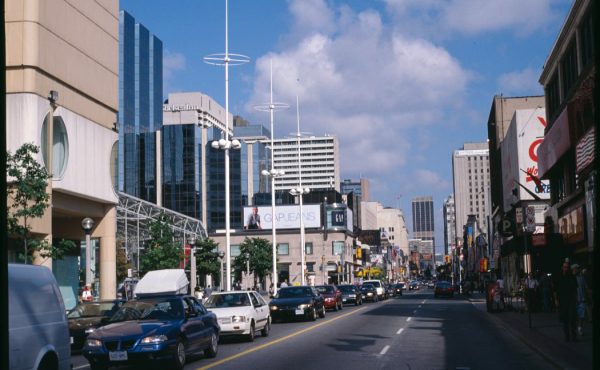
I just stumbled across a few photos of transit shelter designs in Curitiba, Brazil. These seem to be used on an LRT line and would perfect for Toronto’s sometimes harsh winter season. As Toronto moves forward with its own Transit City plans, thinking about the elements that the TTC will add to the streetscape will be very important. Ideas and inspiration from other cities like Curitiba will be crucial.




14 comments
Very cool! These images remind me very much of Chris Hardwicke’s Velo City http://www.velo-city.ca/MainFrameset.html
Can anyone say wind tunnel? Brrr….
Actually, I believe these are used on Curitiba’s bus system. It speeds up the process of getting on the bus by making customers pay before they get on the buses. I recall that there is an elevator (not shown in the photos) for wheelchair patrons at the opposite end of the station.
You can see the doors in the station line up with the doors of a bus, allowing people to get on and off at any door on the bus, not just at the driver’s door, since they have already paid their fares.
Curitiba’s buses are interesting too; they are color coded by route, and they have bi-articulated buses (with two sets of “accordians”)
yes, the best place to find winter-appropriate bus shelters is the polar regions of Brazil.
Sort of makes me hot (er, overheated hot) just looking at them though. All that glass and the Brazilian sun. If they’ve got A/C (solar powered?) they would be fine.
Seems like it would fine in cold climates though, x to x? Why the criticism? Isn’t indoors what you’d want? Please explain.
The wind issue is a valid point, but more germane is to ask: where will the ads go? On the ceiling? The floor? Let’s face it, if such a design were to be implemented in Toronto, the glass would be replaced with solid panels to allow for extensive advertising.
One of the many great things about the Curitiba bus system is that it is completely on the honour system: you punch your card on one of the poles in the bus when you get on, unless you have a transfer in which case you don’t have to do anything. The driver only has to worry about driving, and each stop only takes a few seconds. City officials found that the time saved in this way more than made up for the fares lost to freeloaders.
Sorry to tell you, but the Transit City shelters fall under Astral’s street furniture contract; that is, here’s what they’ll look like.
You can see a rendering of how they’ll appear on Spadina four minutes into this video.
Dave is correct. Curitiba does not have LRT, instead, it has a comprehensive network of bus rapid transit routes with many features that would suit a rail rapid transit system. With level boarding at buses and fare pre-payment in the “tube stations” loading and unloading is fast.
Unfortunately, the express BRT routes are a separate network from the local bus routes, and there’s no co-ordination or free transfers between the two.
I think Transit City will be based on proof-of-payment (rather than fare-paid stations), and with low floors and centre reservation platforms, the boarding should be fairly quick as well.
Mexico City runs BRT in a center ROW on raised platforms kinda like those too. Some pics here: http://www.itdp.org/index.php/news_events/news_detail/mexico_city_launches_brt/
Look! (carefully), it’s the Oscar Meyer bus shelter!
(I kill myself sometimes!)
;-))
If a design would work for Toronto, who cares where it might from? Some people.
The Curitiba system is a model for the kind of Rapid Transit that transit planners want to bring to North America, instead of Rail.
It can never work here. The infrastructure required for these buses is pretty extensive.
yes exactly wind channels